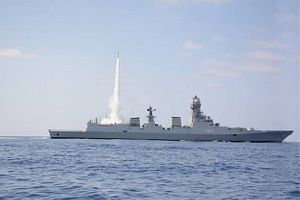Last week, the Indian Navy for the first time in its history conducted a live firing test of a surface-to-air missile using the so-called cooperative engagement capability (CEC) sensor netting system, which allows the real-time sharing of sensor data on incoming air targets among warships.
The test involved the 7,500-ton Kolkata-class (Project 15A) guided-missile destroyers INS Kochi and INS Chennai with each firing a medium-range surface-to-air missile (MRSAM), also referred to as the Barak 8 long-range surface-to-air missile (LRSAM), the Indian Ministry of Defense (MoD) said in a May 17 statement.
“The firing was undertaken on the western seaboard [of India] by Indian naval ships Kochi and Chennai wherein the missiles of both ships were controlled by one ship to intercept different aerial targets at extended ranges,” the MoD statement reads. Put otherwise, CEC allows a warship to detect and, if needed, engage a threat identified by another ship or aircraft.
The test was overseen by Israeli defense firm Israel Aerospace Industries (IAI), and India’s Defense Research and Development Organization (DRDO).
“With the successful proving of this cooperative mode of engagement, the Indian Navy has become a part of a select group of navies that have this niche capability,” the MoD adds. “This capability significantly enhances the combat effectiveness of the Indian Navy thereby providing an operational edge over potential adversaries.”
DRDO last conducted a successful test-firing of a LRSAM from a Kolkata-class guided stealth destroyer in January 2019. Prior to that, the LRSAM was last test fired from an Indian Navy surface combatant in November 2017. Four Indian Navy warships have so far been equipped with LRSAMs.
Next to the Kolkata-class, the missile system is slated to be installed aboard Visakhapatnam-class guided missile destroyers, Kolkata-class destroyers, Kamorta-class anti-submarine warfare corvettes, and Project 17A class of stealth frigates. As I explained in September 2018:
The Barak 8 LRSAM missile defense system has been jointly developed by IAI and [DRDO] in collaboration with defense contractors in India and Israel, including Rafael Advanced Defense Systems. The two countries began join work on the LR-SAM in 2006 with a first successful test firing of the missile system taking place in May 2010.
The vertically-launched two-stage Barak 8, fitted with advanced radio frequency/infrared homing seekers, is designed to deal with a wide range of incoming airborne threats and can intercept targets as close as 500 meters away from a ship. The missile has a maximum speed of Mach 2 and its maximum range is estimated at around 70 kilometers (an extended range version of the Barak 8 can reportedly intercept targets at a distance of up to 150 kilometers.)
LRSAM also features a multifunction active electronically scanned array naval radar system providing 360 degree coverage.
Notably, MRSAM usually refers to the land-based variant of the missile system. By 2023, the Indian Army plans to stand up five MRSAM regiments.
































